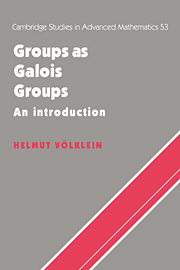Book contents
- Frontmatter
- Contents
- Preface
- Notation
- Part One The Basic Rigidity Criteria
- 1 Hilbert's Irreducibility Theorem
- 2 Finite Galois Extensions of ℂ(x)
- 3 Descent of Base Field and the Rigidity Criterion
- 4 Covering Spaces and the Fundamental Group
- 5 Riemann Surfaces and Their Function Fields
- 6 The Analytic Version of Riemann's Existence Theorem
- Part Two Further Directions
- References
- Index
1 - Hilbert's Irreducibility Theorem
Published online by Cambridge University Press: 22 September 2009
- Frontmatter
- Contents
- Preface
- Notation
- Part One The Basic Rigidity Criteria
- 1 Hilbert's Irreducibility Theorem
- 2 Finite Galois Extensions of ℂ(x)
- 3 Descent of Base Field and the Rigidity Criterion
- 4 Covering Spaces and the Fundamental Group
- 5 Riemann Surfaces and Their Function Fields
- 6 The Analytic Version of Riemann's Existence Theorem
- Part Two Further Directions
- References
- Index
Summary
The definition and basic properties of hilbertian fields are given in Section 1.1. Section 1.2 contains the proof of Hilbert's irreducibility theorem (which says that the field ℚ is hilbertian). We give the elementary proof due to Dörge [Do] (see also [La]).
Section 1.3 is not necessary for someone interested only in Galois realizations over ℚ. It centers around Weissauer's theorem, which shows that many infinite algebraic extensions of a hilbertian field are hilbertian. As our main application we deduce that the field ℚab generated by all roots of unity is hilbertian. Next to ℚ itself, this field is the one that has attracted the most attention in the recent work on the Inverse Galois Problem. This is due to Shafarevich's conjecture (see Chapter 8).
In this chapter, k denotes a field of characteristic 0. (Most results remain true in positive characteristic, with suitable modifications; see [FJ], Chs. 11 and 12.) We let x, y, x1, x2,… denote independent transcendentals over k. Thus k[x1,…, xm] is the polynomial ring, and k(x1,…, xm) the field of rational functions over k in x1,…, xm.
Hilbertian Fields
Preliminaries
We will use elementary Galois theory, as developed in most introductory algebra books, without further reference. (See, e.g., [Jac], I, Ch. 4). The most useful single result will be Artin's theorem (saying that if G is a finite group of automorphisms of a field K then K is Galois over the fixed field F of G and G(K/F) = G).
- Type
- Chapter
- Information
- Groups as Galois GroupsAn Introduction, pp. 3 - 25Publisher: Cambridge University PressPrint publication year: 1996



